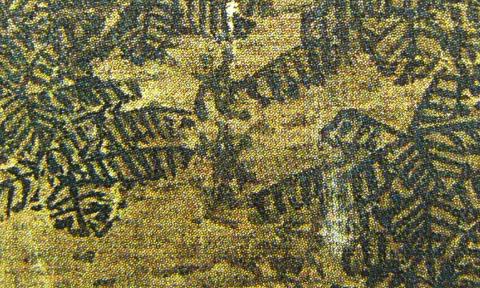Although early Chinese painting concentrated on the depiction of figures, by the Five Dynasties period and the Northern Song Dynasty landscape painting had really come into its own. The finest examples of landscape paintings from this period were extremely influential on later eras, and the artist Fan Kuan (c. 950-1031 AD) was an exemplar of this tradition.
The central mountain dominating Fan Kuan’s Travelers Among Mountains and Streams occupies a full two-thirds of the silk, and is painted from the perspective of a viewer looking up to the far distance from a point at the foot of the mountain. The lower third depicts two hills in the middle ground of the composition, separated by a stream, with two rocky outcrops in the near distance. The foreground, middle ground and background are rendered by combining pingyuan (level) perspective, gaoyuan (high) perspective and shenyuan (deep) perspective within a single composition.
Walking on a path between the hills and rocky outcrops, entering the composition from the right, is a train of four pack donkeys and a pair of travelers, one at the front leading the train, the other bringing up the rear.

Photo: Wikimedia Commons
照片:維基共享資源
The sheer massive scale of the mountain creates a visual tension with the slender white tendril of a waterfall cascading down the right side of the main peak, and enhances the perception of insignificance and vulnerability of the figures traveling through the scene. The narrow path traversing horizontally across the composition at the base of the imposing verticality creates the sense of the passage of time, with the travelers being tiny, insignificant passersby. At the same time, we are privy to the details of their aspect and their gestures. Despite the size of the painting, the layering of so much exquisite detail, still manages to draw the viewer in.
Painters at the time worked solely for the emperor and their works were the exclusive possessions of the emperor. For this reason, artists would not leave their signatures on their paintings. Although this painting was long thought to be the work of Fan Kuan, there was no evidence to support this until 1958, when a researcher at the National Palace Museum in Taipei discovered Fan Kuan’s signature hidden among the leaves of the tree behind the travelers. Following a gap of 1,000 years, the artist Fan Kuan can finally look straight back at admirers of his painting.
(Translated by Paul Cooper)

Photo: Wikimedia Commons
照片:維基共享資源
相較於早期偏重於人物的繪畫,山水畫到了五代和北宋達到了巔峰,其典範影響後世極深,范寬(約西元九五○~一○三一年)即為代表。
范寬的《谿山行旅圖》中,聳立在畫面正中央的巨大山峰,占了三分之二的畫幅,是自山下仰望山巔的「高遠」形式。底下三分之一則是中景的兩座山丘,隔溪相對,以及近景兩塊巨岩。前景、中景、後景分別以「平遠」(平視角)、「高遠」(仰視角)、「深遠」(俯視角)同時並存於同一畫面中。
山丘與巨岩間有一條貫通左右的小徑,一列行旅──包括四匹駝著貨物的驢子,以及領路和押後的兩個人──由右方走入畫面。

Photo: Wikimedia Commons
照片:維基共享資源
山體肅穆龐大的視覺重量,與主峰右側以留白方式形成的細長瀑布形成對比的張力,也讓行旅中的人物動物更顯渺小脆弱。巨大垂直的空間底下,水平的小徑如時間之流,行旅都是渺小的過客,但他們仍是充滿姿勢與表情。如此大的畫幅,卻是由無數精緻的細節累積而成,引人入勝。
當時畫家的作品是為皇帝所作而為皇帝所擁有,因此畫家不在作品上署名。雖傳此畫為范寬所作,但總無實據,直到一九五八年,台北故宮學者發現了范寬的落款──藏在行旅後方的樹葉中。作者范寬終於在千年後,正面與觀者凝視。
(台北時報林俐凱)

The content recommendation algorithm that powers the online short video platform TikTok has once again come under the spotlight after the app’s Chinese owner ByteDance signed binding agreements to form a joint venture that will hand control of operations of TikTok’s US app to American and global investors, including cloud computing company Oracle. Here is what we know so far about its fate, following the establishment of the joint venture. IS BYTEDANCE CEDING CONTROL? While the creation of this new entity marks a big step toward avoiding a US ban, as well as easing trade and tech-related tensions between Washington and Beijing, there

Prompted by military threats from Russia, Denmark has recently passed a new conscription law, officially including women in its military draft for the first time. From July 1, 2025, Danish women, upon turning 18, will be entered into the draft lottery. If selected, they are to serve in the military for 11 months, just as men do. Not only has this decision attracted international attention, but it has also sparked discussions on gender, equality and national defense. Although Denmark’s reform appears to promote gender equality, it primarily responds to regional instability and the need to strengthen national defense. With

A: Happy New Year! I can’t believe it’s 2026 already. Where did you count down? B: I went to pop singer A-mei’s Taitung concert yesterday for the New Year’s countdown. How about you? A: I went to rock band Mayday’s Taichung concert yesterday. Going to their New Year’s shows has become a holiday tradition for me. B: Don’t forget, we’re also going to Jolin Tsai’s show tonight. It’s her first perfomance at the Taipei Dome. A: Yeah, that’s right. It’s great to start the year with good friends and good music. A: 新年快樂!我真不敢相信都已經2026年了。你昨天去哪跨年啦? B: 我昨天去了流行天后張惠妹的台東演唱會,還和她一起跨年倒數。那你呢? A:

Continued from yesterday(延續自昨日) https://www.taipeitimes.com/News/lang Many people attribute the four-leaf clover’s reputation for luck not merely to its rarity but also to the myths and legends that surround it. Here are two such tales that help shed light on how the four-leaf clover came to be seen as a lucky charm. The first story originates from the Biblical narrative of Adam and Eve. According to Christian tradition, Adam and Eve, the first humans created by God, resided in the idyllic Garden of Eden. After they were expelled for defying God’s command, Eve is said to have plucked a four-leaf clover as a